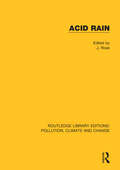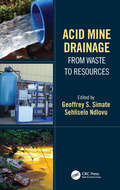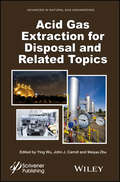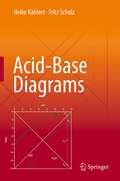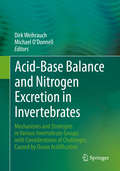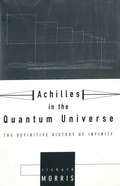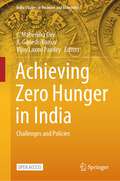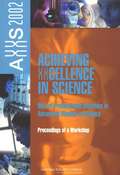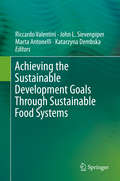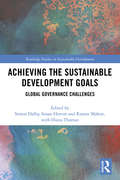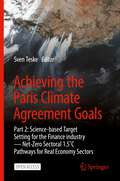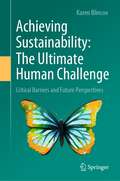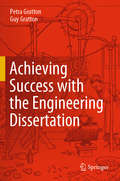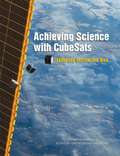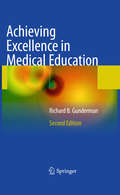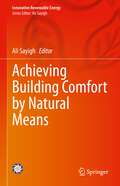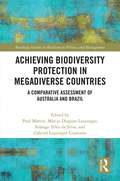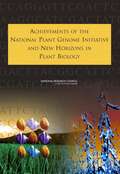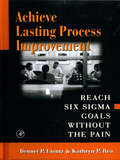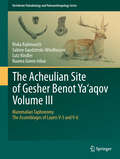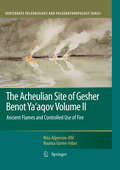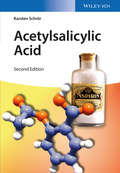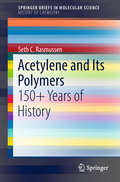- Table View
- List View
Acid Rain: Rhetoric and Reality (Routledge Revivals)
by Chris C. ParkThis title, first published in 1987, provides an authoritative account of both the science and the politics of acid rain. Chris Park places the debates surrounding acid rain in context, and examines the full implications of scientific studies and the effects of acid rain on surface waters, soils and buildings. Evidence is drawn from around the world, including an examination of the damage in Scandinavia and Germany and the effects of acid rain in the U.K. and U.S.A. A comprehensive and relevant work, this is an important guide for students of geography, environment and sustainability and energy policy.
Acid Rain
by J. RoseOriginally published in 1994 this volume includes contributions from environmental scientists, consultants and research workers. The incidence and effects of the phenomenon of acid rain in the late 1970s, 80s and early 1990s , as well as certain remedies, are discussed at length. The roles of vehicles and power stations are examined in detail and legal aspects of curbing acid rain are considered.
Acid Mine Drainage: From Waste to Resources
by Geoffrey S. Simate Sehliselo NdlovuAcid mine drainage (AMD) is essentially the flow of water polluted with metals and other substances from existing/old mining areas and is considered to be one of the sources of pollution. A wide range of technologies are available for preventing AMD generation and/or treating AMD before discharge, but there is a shift towards recovery of industrially useful materials and products from AMD. Acid Mine Drainage: From Waste to Resources explores novel methods developed for the reuse and/or recovery of industrially useful materials from AMD including discussing generation, prediction, prevention, and remediation processes. It includes legislation and policy frameworks governing AMD and its environmental/health impacts. Provides a detailed overview of the mining operations and discusses the geochemical and hydrogeological context of acid mine drainage AMD formation, prediction and impact Presents a holistic approach to AMD generation, prediction, prevention, and remediation processes Presents exclusive material on reuse, recycling, and recovery of industrially useful materials from AMD Gives a detailed overview of the legislation and policy regulatory framework governing the management of AMD Analyses the effects of AMD on the environment and health This volume is aimed at researchers and professionals in metallurgical engineering, chemical engineering, environmental engineering, and mining engineering, including policy makers.
Acid Gas Extraction for Disposal and Related Topics
by Ying Wu John J. Carroll Weiyao ZhuThis is the fifth volume in a series of books focusing on natural gas engineering, focusing on the extraction and disposal of acid gas. This volume includes information for both upstream and downstream operations, including chapters on modeling, carbon capture, chemical and thermodynamic models, and much more. Written by some of the most well-known and respected chemical and process engineers working with natural gas today, the chapters in this important volume represent the most cutting-edge and state-of-the-art processes and operations being used in the field. Not available anywhere else, this volume is a must-have for any chemical engineer, chemist, or process engineer working with natural gas. There are updates of new technologies in other related areas of natural gas, in addition to the extraction and disposal of acid gas, including testing, reservoir simulations, acid gas injection, and natural gas hydrate formations. Advances in Natural Gas Engineering is an ongoing series of books meant to form the basis for the working library of any engineer working in natural gas today. Every volume is a must-have for any engineer or library.
Acid-Base Diagrams
by Heike Kahlert Fritz ScholzUnderstanding acid-base equilibria made easy for students in chemistry, biochemistry, biology, environmental and earth sciences. Solving chemical problems, be it in education or in real life, often requires the understanding of the acid-base equilibria behind them. Based on many years of teaching experience, Heike Kahlert and Fritz Scholz present a powerful tool to meet such challenges. They provide a simple guide to the fundamentals and applications of acid-base diagrams, avoiding complex mathematics. This textbook is richly illustrated and has full color throughout. It offers learning features such as boxed results and a collection of formulae.
Acid-Base Balance and Nitrogen Excretion in Invertebrates: Mechanisms and Strategies in Various Invertebrate Groups with Considerations of Challenges Caused by Ocean Acidification
by Dirk Weihrauch Michael O’donnellThis textbook provides a comprehensive overview on the diverse strategies invertebrate animals have developed for nitrogen excretion and maintenance of acid-base balance and summarizes the most recent findings in the field, obtained by state-of-the-art methodology. A broad range of terrestrial, freshwater and marine invertebrate groups are covered, including crustaceans, cephalopods, insects and worms. In addition the impact of current and future changes in ocean acidification on marine invertebrates due to anthropogenic CO2 release will be analyzed. The book addresses graduate students and young researchers interested in general animal physiology, comparative physiology and marine/aquatic animal physiology. Also it is an essential source for researchers dealing with the effects of increasing pCO2 levels on aquatic animals, of which the vast majority are indeed invertebrates. All chapters are peer-reviewed.
Achilles In the Quantum Universe
by Richard MorrisCenturies ago, when the ancient philosopher Zeno proposedhis famous paradox involving Achilles and the Tortoise, he struck at the heart of one of science's most enduring and intractable problems: How do we define the infinite? From then on, our greatest natural philosophers, logicians, mathematicians, and scientists, from Aristotle to Stephen Hawking, have been stymied-and driven-by infinity.Acclaimed Science writer Richard Morris guides us on a fascinating, literate and entertaining tour of the efforts made throughout history to make sense of the mind-bending concept of the infinite. In tracing this quest, Morris shows us how each new encounter with infinity drove the advancement of physics and mathematics. Along the way, we encounter such luminaries as Galileo and Newton, Tycho Brahe and Giordano Bruno, and the giants of modern physics: Planck, Einstein, Bohr, Feynmann, Hawking, and numerous others.Beginning with simple logical puzzles and progressing to the latest cosmological theories, Morris shows how these same infinity problems helped spawn such groundbreaking scientific developments as relativity and quantum mechanics. Though in many ways, the infinite is just as baffling today as it was in antiquity, contemporary scientists are probing ever deeper into the nature of our universe and catching fleeting glimpses of the infinite in ways the ancients could never have imagined.Ultimately, we see that hidden within the theoretical possibility of an infinite number of universes may lie the answers to some of humankind's most fundamental questions: Why is there something rather than nothing? Why are we here?
Achieving Zero Hunger in India: Challenges and Policies (India Studies in Business and Economics)
by S. Mahendra Dev A. Ganesh-Kumar Vijay Laxmi PandeyThis open access volume discloses rich set of findings and policy recommendations for India towards achieving the SDG 2.1 target of zero hunger by 2030. Through its fourteen chapters, it takes an integrated approach by examining diverse aspects of food and nutrition security through multidisciplinary lens of Agricultural Economics, Nutrition, Crop Sciences, Anthropology and Law, while being rooted in economics. The chapters reflect this diversity in disciplines in terms of the questions posed, the data sets used, and the methodologies followed. Starting from the evolution of policy response for hunger and nutrition security, the book covers aspects such gender budgeting, dietary diversity, women’s empowerment, calorie intake norms, socio-legal aspects of right to health, subjective wellbeing, bio-fortification, crop insurance and food security linkages, interdependence of public distribution system (for food security) and employment guarantee schemes especially during COVID-19 pandemic, effects of dairy dietary supplements, and so on. With its rich discussions, the book is compelling for students, researchers, policy makers, development professionals and practitioners working in areas of food and nutrition security, SDGs, in particular SDG1, SDG2 and SDG5, and sustainable food systems.
Achieving Xxcellence in Science: Role of Professional Societies in Advancing Women in Science
by Committee on Women in Science EngineeringThis report is the proceedings of a July 2002 workshop of the Committee on AXXS 2002: A Workshop for Clinical Societies to Enhance Women's Contributions to Science and their Profession. The workshop gathered representatives of clinical societies and identified ways to enhance the participation of women scientists in the clinical research workforce. This workshop was a follow-up to the AXXS 1999 conference sponsored by the Office of Research on Women's Health (ORWH) at the National Institutes of Health (NIH), which focused on how scientific societies could contribute to the enhancement of women's careers in science.
Achieving the Sustainable Development Goals Through Sustainable Food Systems (Food And Health Ser.)
by Riccardo Valentini John L. Sievenpiper Marta Antonelli Katarzyna DembskaThis publication offers a systemic analysis of sustainability in the food system, taking as its framework the Sustainable Development Goals of the 2030 Agenda of the United Nations. Targeted chapters from experts in the field cover main challenges in the food system and propose methods for achieving long term sustainability. Authors focus on how sustainability can be achieved along the whole food chain and in different contexts. Timely issues such as food security, climate change and migration and sustainable agriculture are discussed in depth. The volume is unique in its multidisciplinary and multi-stakeholder approach. Chapter authors come from a variety of backgrounds, and authors include academic professors, members of CSO and other international organizations, and policy makers. This plurality allows for a nuanced analysis of sustainability goals and practices from a variety of perspectives, making the book useful to a wide range of readers working in different areas related to sustainability and food production. The book is targeted towards the academic community and practitioners in the policy, international cooperation, nutrition, geography, and social sciences fields. Professors teaching in nutrition, food technology, food sociology, geography, global economics, food systems, agriculture and agronomy, and political science and international cooperation may find this to be a useful supplemental text in their courses.
Achieving the Sustainable Development Goals: Global Governance Challenges (Routledge Studies in Sustainable Development)
by Simon Dalby Susan Horton Rianne Mahon Diana ThomazThis book draws on the expertise of faculty and colleagues at the Balsillie School of International Affairs to both locate the Sustainable Development Goals (SDGs) as a contribution to the development of global government and to examine the political-institutional and financial challenges posed by the SDGs. The contributors are experts in global governance issues in a broad variety of fields ranging from health, food systems, social policy, migration and climate change. An introductory chapter sets out the broad context of the governance challenges involved, and how individual chapters contribute to the analysis. The book begins by focusing on individual SDGs, examining briefly the background to the particular goal and evaluating the opportunities and challenges (particularly governance challenges) in achieving the goal, as well as discussing how this goal relates to other SDGs. The book goes on to address the broader issues of achieving the set of goals overall, examining the novel financing mechanisms required for an enterprise of this nature, the trade-offs involved (particularly between the urgent climate agenda and the social/economic goals), the institutional arrangements designed to enable the achievement of the goals and offering a critical perspective on the enterprise as a whole. Achieving the Sustainable Development Goals makes a distinctive contribution by covering a broad range of individual goals with contributions from experts on governance in the global climate, social and economic areas as well as providing assessments of the overall project – its financial feasibility, institutional requisites, and its failures to tackle certain problems at the core. This book will be of great interest to scholars and students of international affairs, development studies and sustainable development, as well as those engaged in policymaking nationally, internationally and those working in NGOs.
Achieving the Paris Climate Agreement Goals: Part 2: Science-based Target Setting for the Finance industry — Net-Zero Sectoral 1.5˚C Pathways for Real Economy Sectors
by Sven TeskeThis open access book is designed as a continuation of the editor’s 2019 book Achieving the Paris Climate Agreement Goals. This volume provides an in-depth analysis of industry sectors globally, and its purpose is to present emission reduction targets in 5-year steps (2025 to 2050) for the main twelve finance sectors per the Global Industry Classification System. This scientific analysis aims to support the United Nations Principles for Responsible Investment initiative to give sustainability guidance for the global finance industry. The industry sector pathways presented here are based on the latest global and regional 100% renewable energy and non-energy greenhouse gas Representative Concentration Pathways in order to keep climate change significantly under +1.5 C and thereby achieve the Paris Climate Agreement goals. The heart of this book is three chapters presenting the results of industry scenario modelling. These chapters cover twelve industry and service sectors as well as transportation and buildings. The specific energy demand and specific emissions are presented based on the emission accounting concept of “Scope 1, Scope 2 and Scope 3” emission pathways. This methodology has been developed to measure the climate and sustainability index for companies, and this research project expands the methodology to apply it to entire industry sectors. The results presented here are the first overall industry assessments under Scope 1, 2 and 3 from 2020 through 2050. The base for the energy pathways is the scenarios scenarios published in the previous volume. The nonenergy GHG emission scenarios, broken down to agriculture & forestry and industry, are detailed and include all major greenhouse gases and aerosols. The final section of the book presents the main conclusions of the industry pathway development work and recommendations for the finance industry and policy makers. Additionally, future qualitative future investment requirements in specific technologies and measures are presented.
Achieving Sustainability: Critical Barriers and Future Perspectives
by Karen BlincoeThe book provides an assessment of whether sustainability is realizable in the current societal framework. What are the challenges and the barriers - and what are the levers necessary to meet and overcome them?Through a revision of the essence of sustainability the book provides an opportunity to understand the deeper level of the radical change that sustainability represents, and the resistance that is preventing its realization.To build the argument the sustainable development model is compared with current development theories as well as alternative solutions based on utopian models of the past. The book assesses the results that can be achieved within the current systemic framework, based on case stories. It outlines the limitations to sustainability, pointing out and defining the multiple, cross-sectoral and systemic barriers that hinder the transition.Finally, the book offers perspectives on achieving a sustainable future, encompassing the impacts from recent events including the pandemic as well as the multiple mitigation and transition initiatives undertaken globally.Brian Goodwin's QuoteLike the caterpillar that wraps itself up in its silken swaddling bands prior to its metamorphosis into a butterfly, we have wrapped ourselves in a tangled skin from which we can emerge only by going through a similarly dramatic transformation.
Achieving Success with the Engineering Dissertation
by Guy Gratton Petra GrattonThis book guides the student reader in preparing their dissertation or major project, including both report and presentation, and explains how to use them as a bridge to the "next big thing" - the graduate's first job, or their next degree.The dissertation is the single most important component of an engineering degree, not only carrying the most marks, but bridging from academic study to professional practice. Achieving Success with the Engineering Dissertation describes the different types of dissertation, how to pick the best project and how a student can prepare themselves to succeed with their own dissertation. The authors explain how best to plan and execute the project, including the roles of the student, supervisor and project sponsor, and what they should expect from each other. Further material includes details of competitions that can be entered with dissertation projects, presentation of data, using the dissertation in job interviews, and creating research publications.Achieving Success with the Engineering Dissertation will be of use to both undergraduate and postgraduate students in all fields of Engineering, and to their supervisors.
Achieving Science with CubeSats: Thinking Inside the Box
by National Academies of Sciences Engineering MedicineSpace-based observations have transformed our understanding of Earth, its environment, the solar system and the universe at large. During past decades, driven by increasingly advanced science questions, space observatories have become more sophisticated and more complex, with costs often growing to billions of dollars. Although these kinds of ever-more-sophisticated missions will continue into the future, small satellites, ranging in mass between 500 kg to 0.1 kg, are gaining momentum as an additional means to address targeted science questions in a rapid, and possibly more affordable, manner. Within the category of small satellites, CubeSats have emerged as a space-platform defined in terms of (10 cm x 10 cm x 10 cm)- sized cubic units of approximately 1.3 kg each called “U’s.” Historically, CubeSats were developed as training projects to expose students to the challenges of real-world engineering practices and system design. Yet, their use has rapidly spread within academia, industry, and government agencies both nationally and internationally. In particular, CubeSats have caught the attention of parts of the U.S. space science community, which sees this platform, despite its inherent constraints, as a way to affordably access space and perform unique measurements of scientific value. The first science results from such CubeSats have only recently become available; however, questions remain regarding the scientific potential and technological promise of CubeSats in the future. Achieving Science with CubeSats reviews the current state of the scientific potential and technological promise of CubeSats. This report focuses on the platform’s promise to obtain high- priority science data, as defined in recent decadal surveys in astronomy and astrophysics, Earth science and applications from space, planetary science, and solar and space physics (heliophysics); the science priorities identified in the 2014 NASA Science Plan; and the potential for CubeSats to advance biology and microgravity research. It provides a list of sample science goals for CubeSats, many of which address targeted science, often in coordination with other spacecraft, or use “sacrificial,” or high-risk, orbits that lead to the demise of the satellite after critical data have been collected. Other goals relate to the use of CubeSats as constellations or swarms deploying tens to hundreds of CubeSats that function as one distributed array of measurements.
Achieving QTS
by John Sharp Jenny ByrneThis book supports trainees on primary initial teacher training courses where a secure knowledge and understanding of science is required for the award of Qualified Teacher Status (QTS). A rigorous test enables trainees to identify their strengths and weaknesses in science and this can be revisited in order to monitor and evaluate progress towards QTS. Trainees are able to direct their studies more usefully and quickly develop confidence in topics they find difficult. This edition is fully up to date with the 2007 QTS Standards.
Achieving Excellence in Medical Education: Second Edition
by Richard B. GundermanA goldmine of theoretical insights and practical suggestions, Achieving Excellence in Medical Education, Second Edition explores the essential question facing medical educators and learners today: What is our vision of educational excellence, and what can we do to enhance our performance? Among the topics explored within this updated, engaging, informative, and thought-provoking text are: * Education's position as a priority of medical schools * Seminal educational insights from non-medical educators * Best practices of outstanding educators and learners * Promises and pitfalls of new educational technologies * Key resources for promoting excellence in medical education * Medical education's role in preparing future leaders * Leadership roles for medical schools in universities and society Reviews of the first edition: "This is an eloquent, quotable, and inspirational book that provides a template for "Achieving Excellence in Medical Education." - Journal of the American Medical Association "Gunderman is an accomplished educator, well known as a thoughtful and provocative teacher. . . I recommend his book to department chairs, clerkship and residency program directors, and education professionals who are shaping the future of medical education." - New England Journal of Medicine
Achieving Building Comfort by Natural Means (Innovative Renewable Energy)
by Ali SayighAchieving Building Comfort by Natural Means explores examples of green building designs and methods that are currently being used around the world to achieve human comfort in buildings. The operation of buildings accounts for more than 40% of total energy use and is a major source of carbon emissions. It is imperative that this consumption be substantially decreased and that energy needed for building comfort is obtained from renewable and environmentally friendly sources. This book brings together a global group of contributors who look at factors such as location, climate, building materials, energy management, ventilation, thermal environmental conditions, shading, lighting, acoustics, and more that are critical for achieving buildings that are more sustainable.Thermal comfort and climatic potential of ventilative cooling in Italian climates is available open access under a Creative Commons Attribution 4.0 International License via link.springer.com.
Achieving Biodiversity Protection in Megadiverse Countries: A Comparative Assessment of Australia and Brazil (Routledge Studies in Biodiversity Politics and Management)
by Paul Martin Márcia Dieguez Leuzinger Solange Teles da Silva Gabriel Leunziger CoutinhoThis volume systematically analyses why legal doctrines for the protection of biodiversity are not sufficiently effective. It examples implementation in Australia and Brazil, two megadiverse countries with very differing legal and cultural traditions and natural environments. Substantial effort goes into the development and interpretation of legal doctrines for the protection of biodiversity in national and international law. Despite this, biodiversity continues in steep decline. Nowhere is this more evident than in megadiverse countries, such as Australia and Brazil, which possess the greatest number and diversity of animals and plants on Earth. The book covers a wide range of topics, including farming, mining, marine environments, indigenous interests and governance. Achieving Biodiversity Protection in Megadiverse Countries highlights specific causes of underperformance in protecting diverse terrestrial and marine environments. It provides proposals for more effective implementation in these two jurisdictions, relevant to other megadiverse territories, and for biodiversity protection generally. Each chapter was written by teams of Australian and Brazilian authors, so that similar issues are considered across both jurisdictions, to provide both country-specific and generalisable insights. Achieving Biodiversity Protection in Megadiverse Countries will be of great interest to students and scholars of environmental law and governance and biodiversity conservation, as well as policymakers, practitioners and NGOs working in these fields.
Achievements Of The National Plant Genome Initiative And New Horizons In Plant Biology
by National Research Council of the National AcademiesLife on Earth would be impossible without plants. Humans rely on plants for most clothing, furniture, food, as well as for many pharmaceuticals and other products. Plant genome sciences are essential to understanding how plants function and how to develop desirable plant characteristics. For example, plant genomic science can contribute to the development of plants that are drought-resistant, those that require less fertilizer, and those that are optimized for conversion to fuels such as ethanol and biodiesel. The National Plant Genome Initiative (NPGI) is a unique, cross-agency funding enterprise that has been funding and coordinating plant genome research successfully for nine years. Research breakthroughs from NPGI and the National Science Foundation™ (NSF) Arabidopsis 2010 Project, such as how the plant immune system controls pathogen defense, demonstrate that the plant genome science community is vibrant and capable of driving technological advancement. This book from the National Research Council concludes that these programs should continue so that applied programs on agriculture, bioenergy, and others will always be built on a strong foundation of fundamental plant biology research.
Achieve Lasting Process Improvement
by Bennet Lientz Kathryn ReaMethods of improving business processes are developed on an ongoing basis, but few are successful. Common problems encountered include the failure of processes to meet expectations and the inability to sustain or replicate these business processes. Involvement of personnel at grassroots level, as well as at management level, is essential in implementing effective process improvement methods. The authors present a step-by-step approach to the issue of effective process improvement, offering more than 200 tips and guidelines as well as addressing specific common problems and issues. The strategy presented is to take a broad and intuitive, but learned view of process improvement methods, and the tactics expounded are based on guidelines, common faults, and lessons learned. The authors disparage process improvement operations that depend on jargon and the support of just upper management, and promote grassroots involvement and self-sustaining measurement, making this an essential guide for all with involvement in process improvement.
The Acheulian Site of Gesher Benot Ya‘aqov Volume III
by Lutz Kindler Naama Goren-Inbar Rivka Rabinovich Sabine Gaudzinski-WindheuserMultidisciplinary research on the Early-Middle Pleistocene site of Gesher Benot Ya'aqov has yielded abundant climatic, environmental, ecological and behavioral records. The 15 archaeological horizons form a sequence of Acheulian occupational episodes on the shore of the paleo-Lake Hula. These enable us to reconstruct numerous aspects of the survival and adaptation of ancient hominins, leading to a better understanding of their evolution and behavior. This book presents the faunal analyses of medium-sized and large mammals, providing taxonomic, taphonomic and actualistic data for the largest faunal assemblages. The study of modes of animal exploitation reveals valuable information on hominin behavior.
The Acheulian Site of Gesher Benot Ya’aqov Volume II
by Naama Goren-Inbar Nira Alperson-AfilThe manipulation of fire by early hominins was a turning point in our evolutionary history. Once "domesticated", fire provided warmth, light and protection from predators, as well as enabling the exploitation of a new range of foods. This book presents the spatial analyses of burned and unburned flint items which provide evidence for the controlled use of fire at the 790,000-year-old Acheulian site of Gesher Benot Ya'aqov (GBY). Clusters of burned flint, interpreted as the remnants of hearths, occur throughout the entire occupational sequence of the site. The fact that fire is repetitively used suggests that the knowledge of fire-making and the technological skills of the Acheulian hominins of Gesher Benot Ya'aqov enabled them to set fire at will in diverse environmental settings. "Control of fire marks a significant landmark in human evolution, providing warmth, protection, and many new foods. This important volume compellingly shows that fire was already in regular use some 800,000 years ago." John D. Speth, Museum of Anthropology, University of Michigan, Ann Arbor, USA "A major contribution to knowledge of early human fire history, the finds at Gesher Benot Ya'aqov add immensely to the picture of our early ancestors by the fireside. The authors present a painstaking and multidimensional scientific investigation which should convince even sceptics of the importance of fire use in prehistory" John A.J. Gowlett, British Academy Centenary Research Project, The Archaeology of the Social Brain, UK.
Acetylsalicylic Acid
by Karsten SchrörWritten by a leading expert on Aspirin-related research, this is the first comprehensive treaty of the history, pharmacological effects and clinical applications of one of the most successful drugs ever. The text is written with a wide audience in mind, and to be readily understandable for clinicians, pharmacists, biomedical researchers and pharmacologists alike. This second, completely revised edition contains the latest results of clinical and pharmacological research on Acetylsalicylic acid, addressing the multiple pharmacological properties of this famous drug with a balanced view on their translation into clinical practice, including prevention from cardiovascular diseases and colorectal cancer.
Acetylene and Its Polymers: 150+ Years of History (SpringerBriefs in Molecular Science)
by Seth C. RasmussenThis Brief presents for the first time a detailed historical overview of the development of acetylene polymers, beginning with the initial discovery of acetylene in 1836 and continuing up through the 2000 Nobel Prize in Chemistry. The polymerization of acetylene is most commonly associated with polyacetylene, which was found to be conductive when treated with oxidizing agents such as Br2 or I2 in the mid‐to‐late 1970s. In fact, under the right conditions, oxidized polyacetylenes can exhibit conductivities into the metallic regime, thus providing the first example of an organic polymer exhibiting metallic conductivity. As a consequence, the 2000 Nobel Prize in Chemistry was awarded to Hideki Shirakawa, Alan MacDiarmid, and Alan Heeger for this pioneering research, the award citation reading “for the discovery and development of electrically conductive polymers.” Because of this, most incorrectly view polyacetylene, as well as conducting polymers in general, to originate in the 1970s. In this work, the author examines the polymerization of acetylene from early thermal polymerization studies to the ultimate production of the fully conjugated polyacetylene. Although true polyacetylene was not successfully produced until the 1950s by Giulio Natta, the polymerization of acetylene dates back to 1866 with the work of Marcellin Berthelot. These initial efforts were continued by a range of scientists to produce a polymeric material collectively given the name cuprene in 1900 by Paul Sabatier. Between the initial cuprene studies and the production of true polyacetylene, two related materials were also studied, usually referred to as polyenes and polyvinylenes. Although both of these materials could be thought of as forms of polyacetylene, neither was actually generated from the direct polymerization of acetylene. Readers will gain insight into the fact that polyacetylene and conducting organic polymers have a much longer history than commonly believed and involved the work of a significant number of Nobel Laureates.

